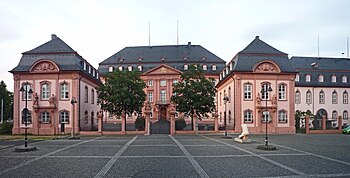Deutschhaus Mainz

The Deutschhaus (or Deutschordenshaus ) in Mainz is the current seat of the Rhineland-Palatinate state parliament .
Construction and history
The foundation stone for the baroque palace on the Rhine side of the city was laid in 1730 by Franz Ludwig von Pfalz-Neuburg . He had been Archbishop of Mainz since January 30, 1729 . At the same time he held the office of Grand Master of the Teutonic Order along with several others . As such, he claimed, in addition to his actual residence as archbishop, the electoral palace located in the immediate vicinity, another residence building for the office of grand master .
The building was completed by Anselm Franz Freiherr von Ritter zu Groenesteyn under the influence of the French Baroque by 1737. Well-known artists such as the Augsburg fresco painter Christoph Thomas Scheffler , the Castelli family of stucco workers from Würzburg and the court sculptor Burkard Zamels from Mainz designed the Knights' Palace into one of the most magnificent secular buildings in the Kurmainzer area. Archbishop Franz Ludwig von Pfalz-Neuburg had already been dead five years when it was completed, so that a Grand Master of the order never resided here.
During the short-lived Mainz Republic , which can be considered the first democracy on German soil, the building was used as the seat of the Rhine-German National Convention . In 1793 this convention acted as parliament for the areas on the left bank of the Rhine occupied by France, until they were recaptured by Allied (German) troops in the same year.
Napoleon later had his residence here from 1798 to 1814, when the city was part of the French Empire . After the reorganization of the Congress of Vienna, when the city became part of the Grand Duchy of Hesse-Darmstadt , the Deutschhaus served as the secondary residence of the Hessian Grand Duke.
In October 1919 Jean-Marie Degoutte was appointed Commander in Chief of the French Army on the Rhine and at the same time a member of the Conseil supérieur de guerre . He and his successor Adolphe Guillaumat resided in the Deutschhaus until the French left on June 30, 1930.
In 1945 the building was badly damaged in bombing raids , only the facades were left. However, it was rebuilt as early as 1950/51 as one of the first of the numerous representative buildings of the electoral residence city. The outer walls were reconstructed while the interior was appropriately adapted. Since then, the palace has served as a plenary building for the Rhineland-Palatinate state parliament.
On the occasion of the 220th anniversary of the Republic of Mainz, the square in front of the Deutschhaus was renamed Platz der Mainzer Republik in 2013 .
The building has been refurbished since the end of October and the beginning of November 2015. The state parliament administration has since been housed in the building of the former Mainz penal institution. The meetings take place in the council chamber of the Mainz town hall and, after appropriate production, in the stone hall of the Landesmuseum Mainz .
Others
- In the plenary hall of the Rhineland-Palatinate state parliament hangs an original of the black, red and gold flags that were publicly carried at the Hambach Festival in 1832 .
- The New Armory , which houses the State Chancellery of Rhineland-Palatinate, adjoins the Deutschhaus directly to the southeast .
- On the Deutschhausplatz in front of the palace there is a replica of the Mainz Jupiter Column found in 1904 , the original of which is in the Landesmuseum Mainz .
See also
literature
- Rolf Dörrlamm, Susanne Feick, Hartmut Fischer, Hans Kersting: Mainz contemporary witnesses made of stone. Architectural styles tell 1000 years of history. Verlag Hermann Schmidt, Mainz 2001, ISBN 3-87439-525-1
- State Office for Monument Preservation Rhineland-Palatinate (Ed.): Cultural monuments in Rhineland-Palatinate. Volume 2.2 .: City of Mainz - Old Town. in: Monument topography of the Federal Republic of Germany . Wernersche Verlagsgesellschaft, Worms 1997 (3rd edition), ISBN 3-88462-139-4
- Michael Kißener : Beginnings of modern democracy in Mainz - The "Deutschhaus" as a place of remembrance, series of publications by the Landtag Rhineland-Palatinate, issue 51, ISSN 1610-3432 .
Individual evidence
- ↑ Friedrich Schütz : From the Teutonic Order House to the Seat of the State Parliament ( Memento from January 21, 2017 in the Internet Archive )
- ↑ Press release of the Mainz State Chancellery (March 18, 2013)
- ↑ The renovation of the stone hall of the Mainz State Museum has started on lbbnet.de; online on the Internet: November 2, 2015
Web links
Coordinates: 50 ° 0 ′ 19 ″ N , 8 ° 16 ′ 18 ″ E

